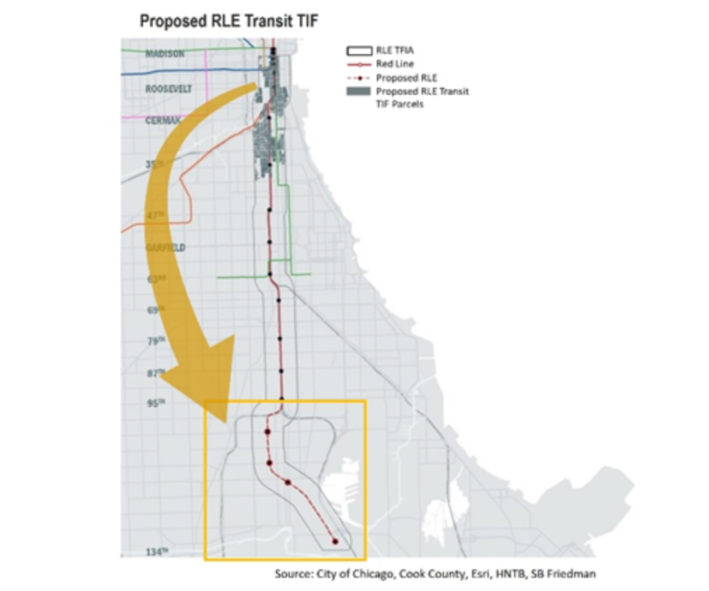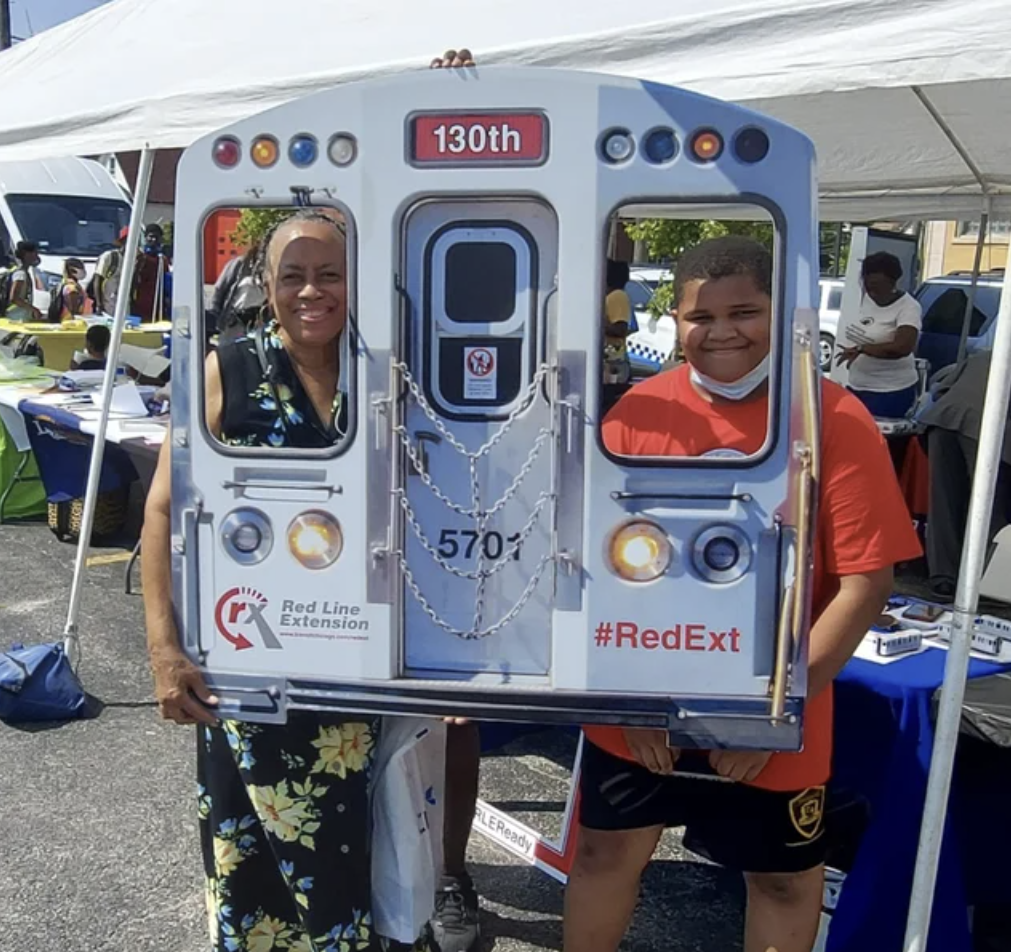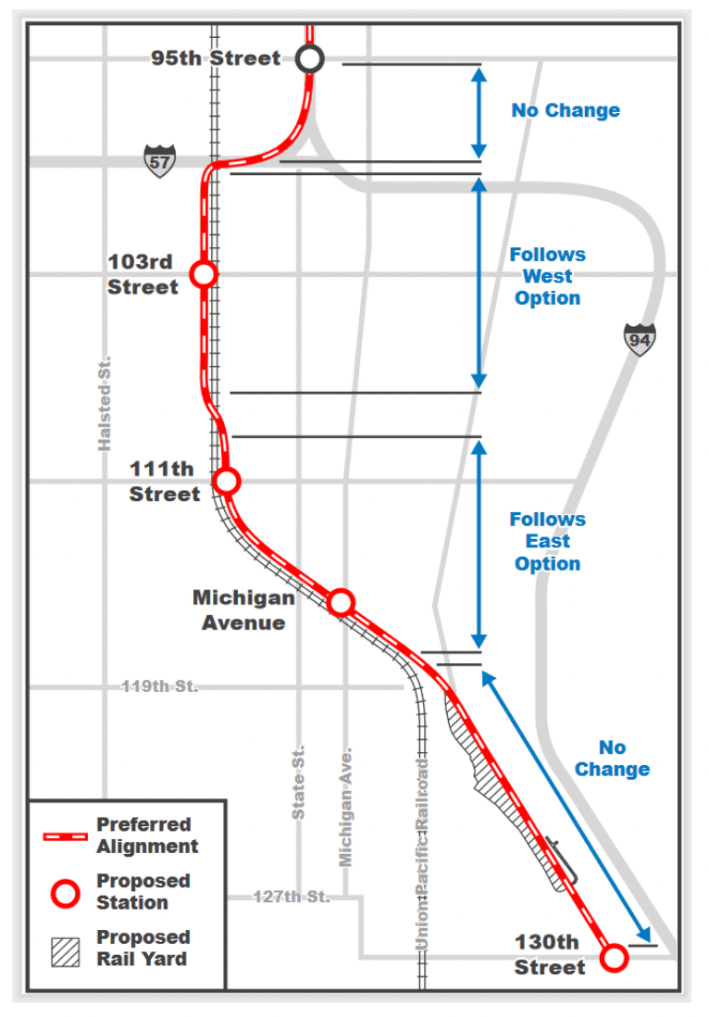This piece incorporates earlier reporting by Igor Studenkov.
Sustainable transportation advocates can accomplish big things when when we all pull together in the same direction. One campaign that calls for this approach is the effort to get a transit-tax-increment financing district passed to help pay for the $3.6 billion South Red Line extension. The route would run 5.6 miles from the 95th-Dan Ryan station in Roseland to 130th Street in Altgeld Gardens, through predominantly African-American areas where people have been asking for 'L' service since the Nixon era. It's projected to cut 30 minutes off the one-way transit commute time from 130th Street to the Loop.
As we've previously discussed on Streetsblog Chicago, A Transit TIF works similarly to any other tax increment financing district, in that the amount of property tax revenue the city and other taxing bodies get from the zone is frozen, and any additional property tax money generated in the future is deposited in the TIF fund. The key difference with a Transit TIF is that, as the name suggests, it’s used specifically for transit projects, and it’s designed to not divert any funding from public schools. The city previously established a Transit TIF district to fund the CTA’s Red and Purple Modernization program. That district is a zone several blocks wide along the Red Line tracks between North and Devon avenues.
The RPM TIF was relatively uncontroversial because the project that would be funded lies entirely within the TIF zone. Therefore, all of the residents who would have their property taxes diverted into the TIF would directly benefit from the investment in terms of improved transit access and increased property values.
In contrast, the proposed South Side Transit TIF would collect revenue from land parcels located several miles north of the Red Line Extension project area in order to fund that initiative. The zone would include parts of the Loop, the South Loop, Chinatown, Bridgeport, Fuller Park and Bronzeville. The TIF is projected to generate up to $950 million, with the rest of the project funding coming from federal sources and bond sales. Mayor Lightfoot hopes to get the district approved by the end of 2022.
The project is now in the preliminary engineering phase. The CTA projects work will start in 2025, and service will launch in 2029.

At a City Council budget hearing On October 14, when Maurice Cox, commissioner of the Department of Planning and Development, made a pitch for the new Transit TIF. But alderpersons noted that CTA president Dorval R. Carter Jr. hadn't even bothered to show up for a City Hall hearing a month earlier on poor transit service.
"What are you going to do with Dorval Carter and his commission to get them to listen to the City Council if we're going to dole out potentially a billion dollars?" asked Finance Committee chair Near North Side alder Scott Waguespack (32nd), according to a report by Justin Lawrence in Crain's.
Budget Committee chair Ald. Pat Dowell (3rd), whose Near South Side district would be included in the Transit TIF, indicated she isn't sure if she'll support the Red Line funding proposal. "I think many of us in here want to make sure that we have a discussion that looks comprehensively at CTA and what they want to do."
Downtown alder Brendan Reilly (42nd) argued that the city shouldn't be asked "to extend a system that's failing," which currently has major reliability and safety issues, Crain's reported. "Certainly, folks on the South Side deserve access to the Red Line, but rewarding poor stewardship with a $1 billion investment, it's difficult to rationalize... There's a lot of explaining to do on the CTA's part before we can go ahead with that initiative."
Carter finally showed up for a council transportation committee hearing last Thursday, where he faced similar questioning, according to a report by the Sun-Times' Fran Spielman. "We know that you’re gonna come back and ask for a very large amount of money [for the Red Line extension]," said Southwest Side alderperson Derrick Curtis (18th). "I have a lot of constituents who say, ‘I would ride any train except the Red Line because we’ve had so much crime, for whatever reason, on that Red Line.'” Carter responded that additional unarmed security guards, dog patrols, and police officers have been deployed on the line recently.
First Ward chief of staff Nicholas Zettel argued on Twitter that racism and classism is a major factor in why the RPM TIF, which includes relatively affluent, majority-white Lakeview, as well as more ethnically and economically diverse communities further north, faced relatively little opposition, but the Red Line extension TIF is getting plots of pushback.

I think that assessment misses the important distinction that the money collected by the RPM TIF is being reinvested in the same areas, whereas the RLE TIF is a "Robin Hood" initiative that takes property tax revenue from wealthier areas and redistributes it to poorer ones.
Debbie Liu, a Metropolitan Planning Council staffer who formerly worked at the Coalition for a Better Chinese American Community, based in Chinatown where some residents are opposed to having their property taxes sent to the Far South Side, said she believes there are several factors in the current TIF skepticism.

Regardless of the reasons for the opposition, the south Red Line extension TIF is currently the only funding proposal on the table to come up with the local funding match necessary to unlock billions in federal grant for the project. As such, transportation advocates should be working to persuade other Chicagoans that, while the project will take place on the Far South Side, where it will help improve life outcomes for local people – including better access to jobs, education, and healthcare – it also will benefit residents in other parts of the city.
That's exactly what UIC urban planning professor Kate Lowe attempted to do in a recent Chicago Tribune op-ed. She noted that the Red Line extension is estimated to increase the number of jobs that can be reached within an hour from the project area by 46 percent. It will also spur investment in housing and retail along the corridor.
Lowe discussed the pushback to the proposed TIF from residents who don't want to "share" property tax revenue, noting, "A Red Line extension rider may be your child’s teacher or someone who maintains the facilities in your office; they have a right to equitable transit." She also pointed out that it's not like the tax revenue would all be poured back into the proposed Transit TIF districts if the TIF was not created – instead it would just go to the city's general fund.
"Securing funding and overcoming obstacles to major projects typically take great collective capacity across cities and regions," Lowe concluded. "Sitting on the sidelines does not deliver progress toward racial equity."
The Active Transportation Alliance and Chicago Sun-Times architecture critic Lee Bey have also written opinion pieces in support of the new transit TIF. And on Saturday Near North Side alder Tom Tunney had a letter in the Sun-Times calling on the state of Illinois to help fund the project.
Contact your alderperson to voice support for the south Red Line extension transit TIF.





